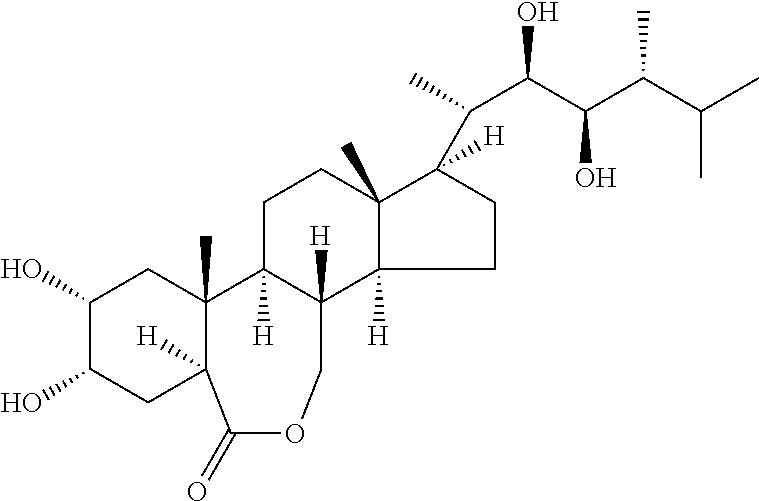Methods and compositions for introduction of exogenous dsrna into plant cells
a technology of exogenous dsrna and plant cells, applied in the field of rna methods and compositions, can solve the problems of affecting crop growth and yield, pest pressure may also have a substantial negative impact, and disrupting a vital insect process,
- Summary
- Abstract
- Description
- Claims
- Application Information
AI Technical Summary
Benefits of technology
Problems solved by technology
Method used
Image
Examples
example 1
Silencing of ZsGreen in Transgenic Maize Plants
[0081]ZsGreen-transgenic maize vector 15779 was created and is shown in FIG. 1. The ZsGreenfluorescent protein is more fully described in a publication entitled: Reef-Coral proteins as visual, non-destructive reporters for plant transformation. Plant Cell Rep (2003) 22:244-251. The vector was transformed into disarmed Agrobacterium tumafaciens strain LBA4404 containing helper plasmid pSB1.
[0082]dsRNA was generated from known ZsGreen sequence. Various lengths of dsRNA derived from a target gene may be used according to the invention. By way of example only, the following sequence was used in the formulation of the invention. This sequence is a dsRNA version of the DNA coding sequence SEQ ID NO 1:
[0083]The dsRNA formulation (dsRNA treatment) included about 250 ng / ul dsRNA, H2O, and a plant hormone brassinosteroid (BR) at about 0.8 micromolar to about 1.6 micromolar. The control solution was the same solution, absent ZsGreen dsRNA.
[0084]In...
example 2
Silencing of Maize Glutamine Synthetase
[0092]A similar experiment was performed using dsRNA generated from the known maize glutamine synthetase RNA sequence Zma-GS dsRNA was synthesized using the AmpliScribe™ T7-Flash™ Transcription Kit, Epicentre® (an Illumina Company) according to manufacturer's suggested protocol. The Zma-GS dsRNA molecule used in this embodiment is a double-stranded RNA version of SEQ ID NO 2. Methods for formulation of dsRNA and control solutions, plant growth conditions, and application of RNAi formulation were as described in the above example, with the exception that another control formulation was added with only Brassinosteroid at 0.1 micromolar.
[0093]Results were evaluated from leaf samples taken 2-3 weeks after treatment. Four plants were examined from each treatment group. Phenotypically, bleaching was observed on the dsRNA treated plants. Since glutamine synthetase is a natively expressed gene, qPCR analysis was performed to calculate silencing efficie...
example 3
Silencing of NtFtsH Transcript in Tobacco
[0094]The tobacco gene encoding Filamentation temperature-sensitive H (NtFtsH) protease was evaluated for silencing using dsRNA constructs in combination with BR. Tobacco was chosen as a model dicot plant system, and these experiments demonstrate that this approach is valid in dicotyledenous species as well. Similar to Example 2, dsRNA was synthesized using AmpliScribe™ T7-Flash™ Transcription Kit, Epicentre® (an Illumina Company) according to manufacturer's suggested protocol. The NtFtsH protease dsRNA molecule used in this embodiment is a double-stranded RNA version of SEQ ID NO 3.
[0095]Once germinated, tobacco plants were transplanted to new soil and grown for an additional 3-4 weeks. Three tobacco plants were chosen for treatment for either the dsRNA or the control formulation. The treatments were applied using methods similar to those described in Example 2. Here, the control formulation contained ZsGreen dsRNA. The tobacco plants did no...
PUM
| Property | Measurement | Unit |
|---|---|---|
| concentration | aaaaa | aaaaa |
| length | aaaaa | aaaaa |
| temperature | aaaaa | aaaaa |
Abstract
Description
Claims
Application Information
 Login to View More
Login to View More - R&D
- Intellectual Property
- Life Sciences
- Materials
- Tech Scout
- Unparalleled Data Quality
- Higher Quality Content
- 60% Fewer Hallucinations
Browse by: Latest US Patents, China's latest patents, Technical Efficacy Thesaurus, Application Domain, Technology Topic, Popular Technical Reports.
© 2025 PatSnap. All rights reserved.Legal|Privacy policy|Modern Slavery Act Transparency Statement|Sitemap|About US| Contact US: help@patsnap.com


